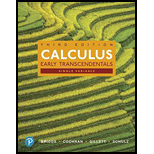
Concept explainers
Explain why or why not Determine whether the following statements are true and give an explanation or counterexample.
- a. A region R is revolved about the y-axis to generate a solid S. To find the volume of S, you could either use the disk/washer method and
integrate with respect to y or use the shell method and integrate with respect to x. - b. Given only the velocity of an object moving on a line, it is possible to find its displacement, but not its position.
- c. If water flows into a tank at a constant rate (for example 6 gal/min), the volume of water in the tank increases according to a linear function of time.
(a)
Whether the statement “A region R is revolved about the y axis to generate a solid S. To find the volume S, you could use either the disk/ washer method and integrate with respect to y or the shell method and integrate with respect to x.” is true or false.
Answer to Problem 1RE
The statement is true.
Explanation of Solution
The shell method is a method of finding volumes by decomposing a solid of revolution into cylindrical shells.
Suppose that a thin vertical strip is revolved about the y axis. An object of revolution (one that looks like a cylindrical shell or an empty tin can with the top and bottom removed) is obtained.
Then the resulting volume of the cylindrical shell is the surface area of the cylinder times the thickness of the cylindrical wall, which is shown below.
Disk method models the resulting three dimensional shape as a stack of an infinite number of disks of varying radius and infinitesimal thickness.
This is in contrast to shell integration which integrates along the axis perpendicular to the axis of revolution.
Thus, the given statement is true.
(b)
Whether the statement “Given only the velocity of an object moving on a line, it is possible to find its displacement, but not its position.” is true or false.
Answer to Problem 1RE
The statement is true.
Explanation of Solution
In order to find the displacement between two time periods, it is required to integrate the velocity between given time periods.
To evaluate the position at any time, that is either the initial position of the object at any given time or at least the position of the object at a particular time is required.
Thus, the given statement is true.
(c)
Whether the statement is “If water flows into a tank at a constant rate (for example 6gal/min.), the volume of water in the tank increases according to a linear function of time” is true or false.
Answer to Problem 1RE
The statement is true.
Explanation of Solution
If
Here the rate of inflow is in units of volume per unit time.
Hence, the change in volume in the tank will also be linear.
Thus, the given statement is true.
Want to see more full solutions like this?
Chapter 6 Solutions
Single Variable Calculus: Early Transcendentals, Books a la Carte, and MyLab Math with Pearson eText -- Title-Specific Access Card Package (3rd Edition)
- For the right circular cylinder, suppose that r=5 in. and h=6 in. Find the exact and approximate a lateral area. b total area. c volume.arrow_forwardFind the exact volume of the solid that results when the triangular region with vertices at 0, 0, 5, 0 and 0, 9 is rotated about the a x-axis b y-axisarrow_forwardFind the exact lateral area of each solid in Exercise 40. Find the exact volume of the solid formed when the region bounded in Quadrant I by the axes and the lines x = 9 and y = 5 is revolved about the a) x-axis b) y-axisarrow_forward
 Mathematics For Machine TechnologyAdvanced MathISBN:9781337798310Author:Peterson, John.Publisher:Cengage Learning,
Mathematics For Machine TechnologyAdvanced MathISBN:9781337798310Author:Peterson, John.Publisher:Cengage Learning, Elementary Geometry For College Students, 7eGeometryISBN:9781337614085Author:Alexander, Daniel C.; Koeberlein, Geralyn M.Publisher:Cengage,
Elementary Geometry For College Students, 7eGeometryISBN:9781337614085Author:Alexander, Daniel C.; Koeberlein, Geralyn M.Publisher:Cengage, Holt Mcdougal Larson Pre-algebra: Student Edition...AlgebraISBN:9780547587776Author:HOLT MCDOUGALPublisher:HOLT MCDOUGAL
Holt Mcdougal Larson Pre-algebra: Student Edition...AlgebraISBN:9780547587776Author:HOLT MCDOUGALPublisher:HOLT MCDOUGAL Linear Algebra: A Modern IntroductionAlgebraISBN:9781285463247Author:David PoolePublisher:Cengage Learning
Linear Algebra: A Modern IntroductionAlgebraISBN:9781285463247Author:David PoolePublisher:Cengage Learning Elementary Geometry for College StudentsGeometryISBN:9781285195698Author:Daniel C. Alexander, Geralyn M. KoeberleinPublisher:Cengage Learning
Elementary Geometry for College StudentsGeometryISBN:9781285195698Author:Daniel C. Alexander, Geralyn M. KoeberleinPublisher:Cengage Learning




